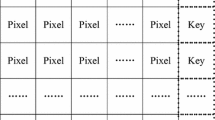Abstract
The paper presents a new approach to generating enciphering sequences useful in information protection, with an illustration on images. The procedure is both theoretically and experimentally supported by combining elements derived from the running-key cipher, information theory and statistics. The enciphering key generator is based on the logistic map, and its theoretical properties are demonstrated by statistical tests. The new enciphering sequences comply with the fair coin model, and the randomly chosen initial conditions of the logistic map (defining the enciphering sequence) can be part of the secret key. Although dealing with a particular case of chaotic system, the paper contains the necessary elements so that the overall procedure can be applied to other chaotic maps (e.g., tent map).








Similar content being viewed by others
References
Pareek NK, Patidar V, Sud KK (2006) Image encryption using chaotic logistic map. Image Vision Comput 24(9):926–934
Zhang L, Liao X, Wang X (2005) An image encryption approach based on chaotic maps. Chaos, Solitons and Fractals 24:759–765
Shujun Li (2006) Analyses and new designs of digital chaotic ciphers. Ph. D. thesis, Xi’an Jiaotong University, China
Li S, Mou X, Cai Y (2001) Pseudo-random bit generator based on couple chaotic systems and its application in stream-ciphers cryptography. Lecture notes in computer science. Prog Cryptol–INDOCRYPT 2247:316–329
Patidar V, Sud KK, Pareek NK (2009) A pseudo random bit generator based on chaotic logistic map and its statistical testing. Informatica 33:441–452
Shannon CE (1949) Communication theory of secrecy systems. Bell Syst Tech J 28:656–715
Kanso A, Smaoui N (2009) Logistic chaotic maps for binary numbers generators. Chaos, Solitons & Fractals 40(5):2557–2568
Patidar V, Sud SK (2009) A novel pseudo random bit generator based on chaotic standard map and its testing. Electron J Theor Phys 6(20):327–344
Luca A, Ilyas A, Vlad A (2011) Generating random binary sequences using tent map. Proc. IEEE Intl. Symposium on Signals, Circuits and Systems (ISSCS 2011), Iaşi, Romania, pp. 81–84 (July)
Diffie W, Hellman M (1979) Privacy and authentication: an introduction in cryptography. Proc IEEE 67(3):397–426
Badea B, Vlad A (2006) Revealing statistical independence of two experimental data sets. An improvement on Spearman’s algorithm. ICCSA 3980:1166–1176, Lecture notes in computer science
Vlad A, Luca A, Frunzete M (2009) Computational measurements of the transient time and of the sampling distance that enables statistical independence in the logistic map. ICCSA 5593:703–718, Lecture notes in computer science
Luca A, Vlad A, Badea B, Frunzete M (2009) A study on statistical independence in the tent map. Proc. IEEE Intl. Symposium on Signals, Circuits and Systems (ISSCS 2009), Iaşi, Romania, pp. 481–484 (July)
Serbanescu A, Rincu CI (2008) Systems et Signaux Face au Chaos: Applications aux Communications (in French). Académie Technique Militaire, Bucharest
Lasota A, Mackey MC (1994) Chaos, fractals, and noise. Stochastic aspects of dynamics. Springer, New York
Luca A, Vlad A (2005) Generating identically and independently distributed samples starting from chaotic signals. Proc. Intl. Symposium on Signal, Circuits and Systems (ISSCS 2005), Iasi, Romania, pp. 227–230 (July)
Arroyo D (2009) Framework for the analysis and design of encryption strategies based on discrete-time chaotic dynamical systems. Ph.D. thesis, Universidad Politécnica de Madrid, Escuela Técnica Superior de Ingenieros Agrónomos, Spain
Shannon CE (1951) Prediction and entropy of printed English. Bell Syst Tech J 30:50–64
Baptista MS (1998) Cryptography with chaos. Physics Letters A 240:50–54
Walpole RE, Myers RH (1989) Probability and statistics for engineers and scientists, 4th edn. MacMillan, NY
Vlad A, Mitrea MP (2001) Digital image protection by means of cryptographic mixing transformations. Proc SPIE 4430:560. doi:10.1117/12.432892
Author information
Authors and Affiliations
Corresponding author
Rights and permissions
About this article
Cite this article
Vlad, A., Ilyas, A. & Luca, A. Unifying running-key approach and logistic map to generate enciphering sequences. Ann. Telecommun. 68, 179–186 (2013). https://doi.org/10.1007/s12243-012-0317-8
Received:
Accepted:
Published:
Issue Date:
DOI: https://doi.org/10.1007/s12243-012-0317-8




